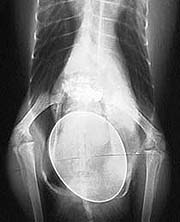
Egg Binding is a problem that occurs most often in the smaller female birds. Canaries, lovebirds, cockatiels, budgies and finches are the commonly affected breeds. Egg binding can be a serious problem, and is considered an emergency, requiring delicate and professional care. Unfortunately, some birds can succumb in spite of this care.
Infection, trauma to the reproductive tract, inadequate nesting area, excessive egg laying, obesity, and nutritional problems are some of the factors involved with this problem. Those birds on all seed diets or those with an inadequate calcium intake are particularly prone. An egg that is too soft can also cause the problem. Some birds are just prone to the problem, and even environmental factors like hypothermia can be involved. Determining the exact cause can be difficult.
Birds that have this problem might exhibit depression, labored breathing, straining, abdominal distention, lack of droppings, fluffed appearance, and poor appetite. There might even be a broken bone due to inadequate calcium. These are also the symptoms of other avian diseases. Pressure from a stuck egg can even interfere with nerve function to the legs. Sometimes the only symptom is your bird sitting at the bottom of the cage. Unfortunately, the only symptom in some cases is a dead bird.
In many egg bound birds there is a history of recent egg laying. Some birds exhibit sexual behavior and even build nests. During physical examination of a bird with a distended abdomen an egg can sometimes be palpated. There are other causes besides egg binding in sick birds with distended abdomens, so it is important to follow a thorough diagnostic process.
X-rays are a significant aid in making this diagnosis, but only if a bird is strong enough. Eggs shells have a high level of calcium, so depending on how well they are developed, might show up vividly on an x-ray. Some eggs are poorly calcified and do not show up well on a radiograph.
It's not difficult to see the egg on this bird that is laying on its back. The circular whitish material just above the egg is grit in the gizzard (ventriculus).

Egg bound birds are very ill and require emergency care. Many are hypothermic and require immediate warming. They can be toxic from the inability to eliminate waste products and dehydrated from poor appetites and weakness, so warm fluids are also administered. If the bird is in shock we will give these fluids via an intraosseus catheter. Calcium is also administered to aid in muscle contractions and hopefully expulsion of the egg on its own. Medications to stimulate the uterus to contract are also used. Whether or not they help depends on the cause of the problem.
If medical therapy does not work we attempt to help in the removal of the stuck egg. Once the bird is more stable we can sometimes gently expel the egg with digital pressure. If the egg is adhered to the uterus digital pressure might not work. Inserting a needle with a syringe attached directly into the egg allows us to collapse the egg and make expulsion easier.
This female is being examined with a lubricated speculum to determine the exact nature of her problem. We can deflate the egg by passing the needle through the speculum. The arrow points to a high intensity cool light that allows greater visualization.

There are factors involved with this problem that we have no control over. Factors we can control are good nutrition, a clean environment, spaying birds that are predisposed to egg binding or are excessive egg layers, minimizing obesity and stimulating exercise.
Careful daily observation of your pets daily habits will help you recognize the early symptoms of this disease. No matter what the problem, any time your pet bird shows any symptoms of a disease, no matter how subtle, it is considered significant and requires immediate veterinary care. This is because birds are masters at hiding illness, and we are all too often presented with sick birds in advanced stages of disease. Our ability to return these birds to normal health is diminished because proper care has not been given early on in the disease process where it is most beneficial.